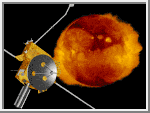|
COMETS EARTH JUPITER KUIPER BELT MARS MERCURY METEORITES NEPTUNE OORT CLOUD PLUTO SATURN SOLAR SYSTEM SPACE SUN URANUS VENUS ORDER PRINTS
PHOTO CATEGORIES SCIENCEVIEWS AMERICAN INDIAN AMPHIBIANS BIRDS BUGS FINE ART FOSSILS THE ISLANDS HISTORICAL PHOTOS MAMMALS OTHER PARKS PLANTS RELIGIOUS REPTILES SCIENCEVIEWS PRINTS
|
Related Document
Download Options
Scientists on the Ulysses mission -- the first spacecraft to explore the third dimension of space over the poles of the Sun -- found some surprising new discoveries about the polar regions of the Sun when the spacecraft passed over the regions in 1994 and 1995. Among them, the spacecraft revealed two clearly separate and distinct solar wind regimes with fast wind emerging from the solar poles. Scientists were surprised by observations of how cosmic rays make their way into the solar system from galaxies beyond the Milky Way. The magnetic field of the Sun over its poles turned out to be very different from previous expectations using ground-based observations. In addition, Ulysses found a beam of particles from interstellar space that was penetrating the solar system at a velocity of close to 50,000 miles per hour. On September 29, 1995, Ulysses completed its first solar orbit and began its voyage back out to the orbit of Jupiter, where it will loop around and return to the vicinity of the Sun in September 2000. At that time the Sun will be in a very active phase of its 11-year solar cycle and Ulysses will find itself battling through the atmosphere of a star that is no longer docile. |
